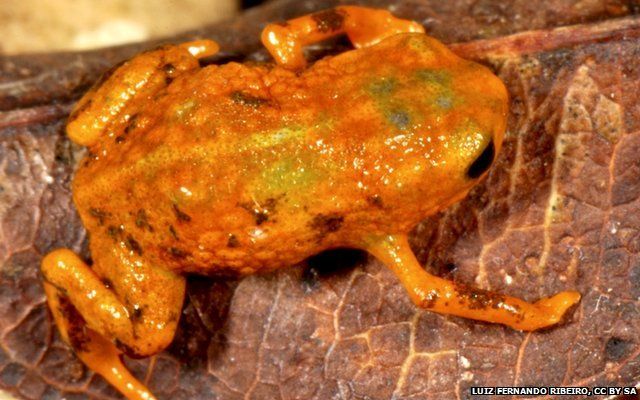Seven tiny frog species found on seven mountains
- Published

Seven new species of tiny frog have been discovered on seven different mountains in south-eastern Brazil.
The cool "cloud forests" of this region have a unique climate, separated by warmer valleys that isolate the peaks like islands.
That isolation has produced 21 known species of Brachycephalus frog - and the new arrivals push that count to 28.
They are all less than 1cm long and many have colourful, poisonous skin to help them avoid becoming tiny meals.
The newly discovered species, reported in the open-access journal PeerJ, are the fruit of five years of expeditions into the wilderness.
Marcio Pie, a professor at the Federal University of Parana in nearby Curitiba, said he had climbed more mountains than he can remember.
"It's really exhausting," he told the BBC. "The mountains are not that high - most of them are 1,000m to 1,500m - it's just that the trails are not particularly well marked."
Guessing game
These high forests near Brazil's southern Atlantic coast are a fertile place for ecologists to explore, Prof Pie said, yielding more different species per square km than the Amazon.
For animals like the Brachycephalus frogs that are particularly sensitive to their environment, even the temperature change from mountain to valley forms a barrier. That leaves the population on each mountain top to slowly develop into a separate species.
The little creatures are rather restricted in terms of just how different they can become. As some of the very smallest land-dwelling vertebrates, much of their anatomy is optimised to this tiny scale. For example, they typically have three toes and two fingers, instead of the five toes and four fingers found in most frogs.
The most obvious differences between Brachycephalus species, including the seven new ones, is their skin. This can vary quite a lot in how bumpy and rough it is, and quite dramatically in its colour - with more vibrant tones normally reflecting higher levels of the deadly chemical tetrodotoxin.
Predicting what a new species might look like became a bit of a game for Prof Pie and his colleagues. "It's a really exciting experience, because we have a good expectation that each mountain top will have a new species, but we don't know what it's going to look like," he said.
"So we play around while we plan each trip, and try to anticipate what the species is going to look like."
Heard not seen
After catching enough specimens, which usually involved rifling through leaf litter with their bare hands, Prof Pie's team also did genetic tests to describe each new species.
Finding them in the first place was probably the biggest challenge, he said.
"It takes a lot of practice and sometimes it's very frustrating, to go up the mountain for many hours and come back empty-handed."
Often the researchers would hear the frogs long before they saw them, but the creatures, whose principal predators are probably snakes, tend not to give away their location easily.
"You can hear them singing and there's probably hundreds of them, but you simply can't catch them! Because once you get closer, just from the vibration in the ground, they keep silent for, say, 20 minutes or half an hour. And then you have to go through the leaf litter very carefully with your hands," Prof Pie said.
Tiptoeing scientists are the least of the frogs' worries, however. The unique climatic pockets of the cloud forests are vulnerable.
"The presence of these frogs with such small geographical ranges suggests to us that this particular area has been pretty stable for last the past 500,000 years, in terms of the climate.
"If it had got warmer, probably the environment that characterises the cloud forests would have disappeared and would have led these species to extinction. Whereas if it had changed in the other direction, probably they would have moved across the valleys and we would find these species together.
"But at this point we've never found more than one species at each site."
Race against time
Prof Pie and his colleagues warn that keeping this remarkable variety of species alive may require captive breeding, as well as efforts to protect their habitat from invasive plant and animal species, logging, and other threats.
Meanwhile, the effort to catalogue the frogs' diversity goes on. The team has already come across another four species, whose details they are yet to publish, and more mountain expeditions are planned.
"We are very confident that we're going to find even more species," Prof Pie said. "There are many other locations where you tend to find a very similar climate and so probably the frogs are going to be there as well."
Ben Tapley, the team leader of herpetology at ZSL London Zoo, said the discovery was noteworthy.
"The description of one, let alone seven species, is always extremely exciting," Mr Tapley said.
"Amphibians are facing catastrophic and global decline and it is likely that many species have become extinct before they have even been described by science. Species descriptions can inform conservation management and help prioritise much needed conservation action."
Follow Jonathan on Twitter
Related Topics
- Published20 April 2015
- Published31 December 2014
- Published30 October 2014
- Published11 January 2012
- Published3 May 2013
- Published16 November 2010